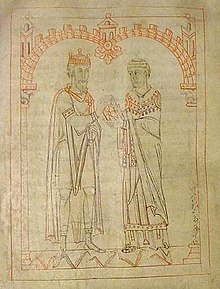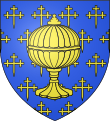Miro (Suebian king)
(Redirected from
Miro (Suevic king)
)
Miro (Mir, Mirio,
Leovigild. During his reign relations were established with both Francia and the Byzantine Empire and the kingdom reached its zenith, but it collapsed within three years of his death.[1][2]
Miro enjoyed good relations with the Church during his reign. In 572 he called the
Dumio in the concilar acts, that Miro himself may have represented that see.[3]
Miro also maintained "intimate and friendly" relations with
Metropolitan of Gallaecia.[2] Martin's principal work, Formula Vitae Honestae, is dedicated to him, and the Exhortatio Humilitatis, printed among Martin's works, is also probably addressed to him.[2] Indeed, Martin advised Miro's counsellors to read his Formula so as to be able better to counsel the king.[4]
In the same year as the council of Braga, Miro conducted an expedition against the
King of Burgundy and a consistent thorn in Leovigild's side, but they were intercepted and detained on the way by Leovigild's ally, Chilperic I, the Frankish king of Neustria.[2][6]
In 575 Leovigild invaded the "Aregensian Mountains" near
Toro). Miro sued for peace, and obtained it for a short time.[2] In 580 Miro endeavoured to support Leovigild's Catholic son Hermenegild in rebellion.[2]
For the events surrounding Miro's death, the contemporary and near-contemporary accounts conflict. According to
John of Biclar and Isidore of Seville, concur that he died before Seville while assisting Leovigild with the siege of the town.[2] Modern scholarship favours Gregory's interpretation, taking into account Miro's alliances with Francia and Byzantium, Suevic animosity to the Goths, and the shared Catholic faith of Sueves and rebels.[7]
He was succeeded in provincia Gallacciæ by his adolescent son
Andeca, who deposed Eboric and took to ruling in Gallaccia Suevorum regnum.[7]
Notes
Sources
- Arias, Jorge C. "Identity and Interaction: The Suevi and the Hispano-Romans." Ph.D. dissertation. University of Virginia: Spring 2007.
- "Miro." In Henry Wace and William C. Piercy, edd. A Dictionary of Christian Biography and Literature. London: John Murray, 1911. Reprinted as Dictionary of Christian Biography and Literature to the End of the Sixth Century A.D., with an Account of the Principal Sects and Heresies. United States: Hendrickson Publishers, 1999. ISBN 1-56563-460-8.

